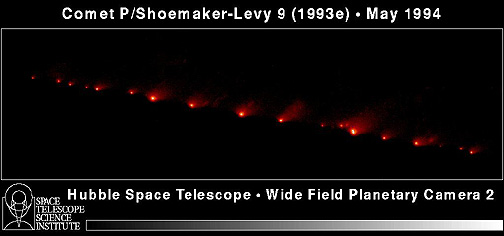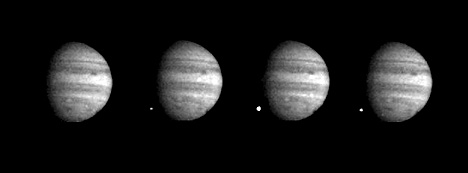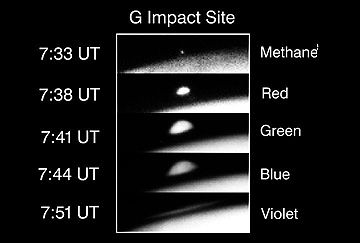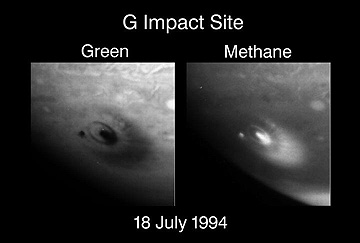

Comet Shoemaker-Levy
In March of 1993, Carolyn Shoemaker, wife of Eugene M. Shoemaker* (the Dean
of Astrogeologists and chief guru of the Impact School), and an accomplished
scientist, particularly for her contributions in the search for asteroids and
comets. She inspected photos taken hours apart using surplus film, from a damaged
batch, having high sensitivity. Shown enlarged and in stereo, a short streak
had a strange but distinct pattern of separated dots, against a fixed star background.
About the same time, their colleague and member of their asteroid search team, David Levy, made similar observations. After reporting their find to other observatories, word came back that the odd arrangement of dots was actually due to a string of individual cometary bodies, each with a small coma and tail, stretched out for more than 700,000 km (434,980 mi) along an orbit tied into Jupiter. Then, in May of 1994, word came that this comet, named Shoemaker-Levy 9 (S-L 9), was on a collision course that would end in a succession of hits onto Jupiter in July of that year. This would be a unique event–the first time humans would witness a major planetary impact!
Scientist believe that Comet S-L 9 originated beyond Neptune. Over centuries of travel, various bodies perturbed its orbit towards Jupiter, so it become a Short-Period comet, whose very eccentric orbit carried it remarkably close to that planet. Calculations showed that S-L 9 had earlier passed as close as 20,000 km (12,428 mi) to Jupiter's surface, well within the Roche Limit (a distance from a planet's center, within which its gravitational forces are likely to disrupt a passing body), and had broken apart then into 21 fragments. Each nucleus was less than 2 km (1.25 mi) in diameter. The HST made this dramatic image:

The world of astronomical science quickly and efficiently mobilized for this event. As more precise estimates of just when and where the collisions would occur, scientists realized that HST and Galileo would be in position to observe at least some of the impacts, and Earth-based telescopes should also see something. Guesses as to what would happen ranged from penetration into the Jovian atmosphere without much occurring, to massive fireballs. Anticipation ran high among the network of watchers.
First to hit was the small nucleus at the left end of the string in the image above. Labeled A (with succeeding ones designated B, C, D ... through W [with I and O omitted]), this body struck Jupiter in its southern hemisphere, producing a detectable flash and subsequent plume picked up by observatories in Spain and Chile. Below, we display the sequence of color IR images made through a telescope fitted with a methane filter (which absorbs radiation at most wavelengths but passes radiation in a narrow band around 2.3 µm):
The changing bright spot on the lower left surface is the thermal flash of the impact (the other bright oval above it is the Great Red Spot and Io is visible to the right). Astronomers monitored most of the subsequent impacts over the next six days either directly or as the impact scars moved into sight during Jupiter's rapid rotation. Galileo's camera caught several on the night side limb. Next, we show W's hit on July 22, sequenced seven seconds apart, showing the flash during and shortly after impact (it looks like a satellite off the planet but is really a momentary response set against the dark surface within the shadowed limb):

One of the biggest events was the strike of nucleus G on July 18. The rapidly rising plume from this, imaged in a time sequence by HST, shows it reached a height of 3,000 km (about 1,864 mi) in about six minutes:

The HST imaged the scar (larger than Earth's diameter) left behind in the surficial layers, through a green and a methane-based filter:

19-76:
Interpreting this, and other scars, shows us that each nucleus punches a tunnel into the Jovian outer atmosphere, shocking, compressing, and flashing its gases. Materials from the incoming comet and the atmosphere carry into the hemispherical plume and also sidewards (influenced by the angle of impact) as crescent-shaped clouds, in much the same manner as those associated with terrestrial impacts on Earth. The dark matter making up the scar is presumably color-altered constituents from the Jovian atmosphere,such as, HCN or sulphur derivatives. Unlike solid ground craters, those on Jupiter gradually dissipated, although their visible traces endured for several years.
The following three views of Jupiter, after all impacts had occurred, demonstrate this persistence. The first is a natural color view made by HST of one side displaying impact sites
The second shows a color IR image taken from the Calar Alto observatory in Spain:
The third image, taken by HST's UV camera, brings scars H, Q, R, D, G and L (the round object in the upper hemisphere is the shadow of one of the moons) into sharp contrast:
Had any of the fragments from S-L 9 struck Earth instead, a catastrophe of a magnitude never before experienced by humanity (but certainly by the dinosaurs) would have ensued. We've been warned!
Thus endeth this great voyage of exploration through the Solar System! The previous 18 sections should have convinced you that our Earth is an extraordinary, yet very livable place. But, this section hopefully has opened your eyes to the fact that the rest of the solar system, while inhospitable, is clearly fascinating in its own right. Recently, astronomers have discovered several new planetary systems elsewhere in our galaxy. Who knows what incredible worlds lie beyond our own? Perhaps someday we’ll remotely sense a sister planet and then, when the technology develops, visit it by probes or even by our species.
* With deep sorrow, we must report
here the death of a good friend and teacher of impact principles, Eugene M.
Shoemaker, who may rightly be called "the father of Astrogeology."
He died on July 18, 1997, in an auto collision (impact, ironically) in the interior
of Australia, while pursuing meteor craters that are so well displayed in that
continent. It is fitting that part of Gene's ashes are onboard Lunar Prospector
and will eventually, when that probe finally descends to the lunar surface,
in a sense "land" on the Moon–a long time goal of his (to be
a lunar astronaut) that health problems thwarted just prior to the Apollo program.

Primary Author: Nicholas M.
Short, Sr. email: nmshort@epix.net
Contributor Information
Last Updated: September '99
Site Curator: Nannette Fekete